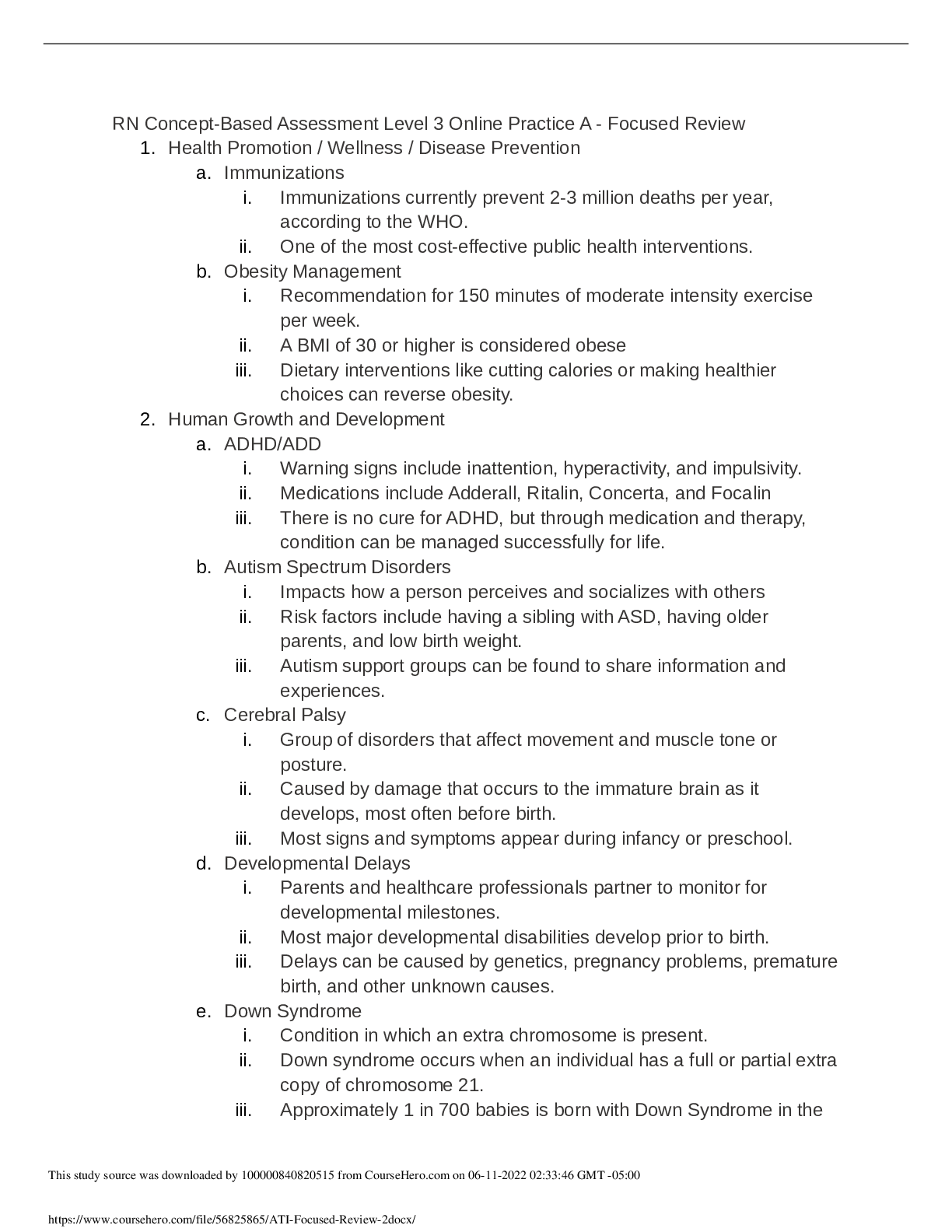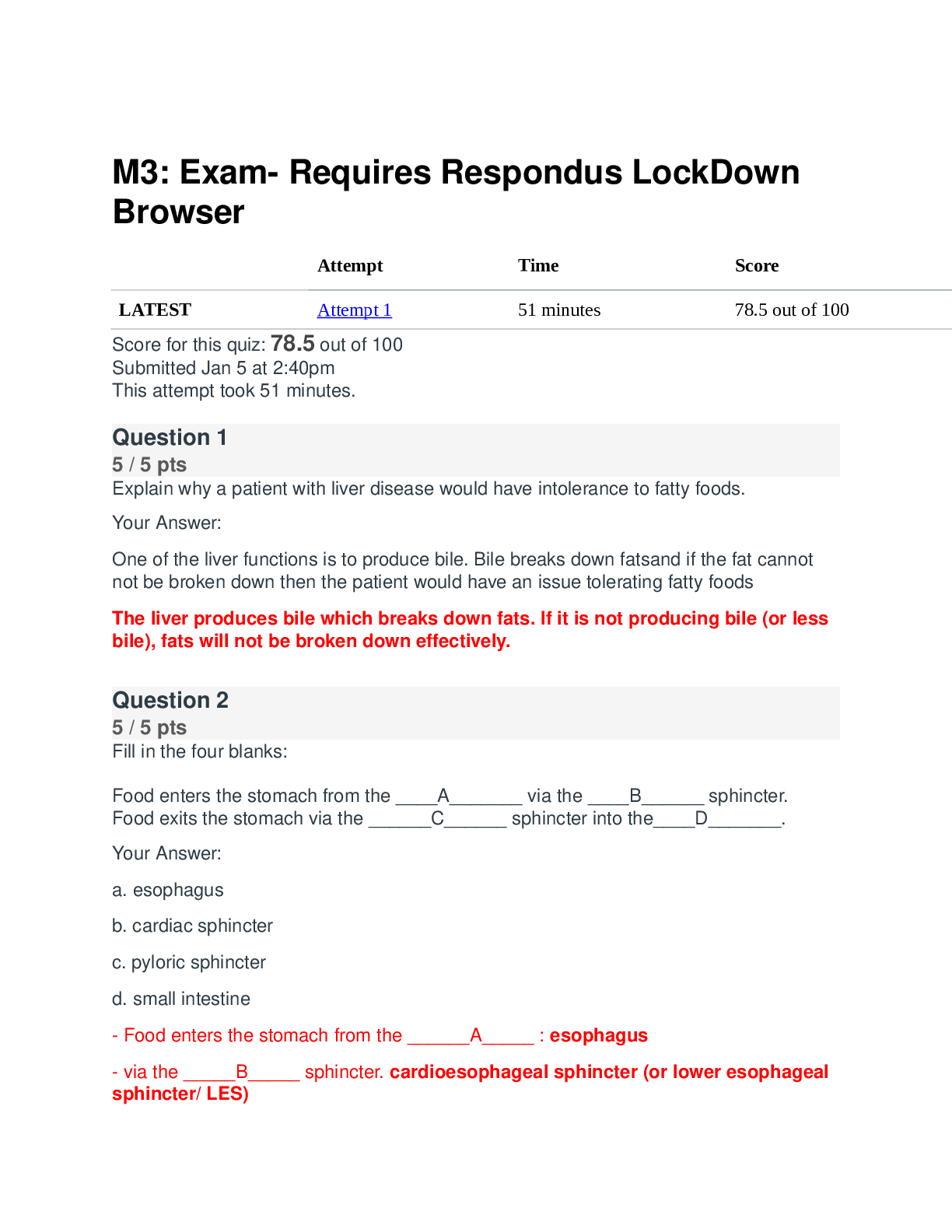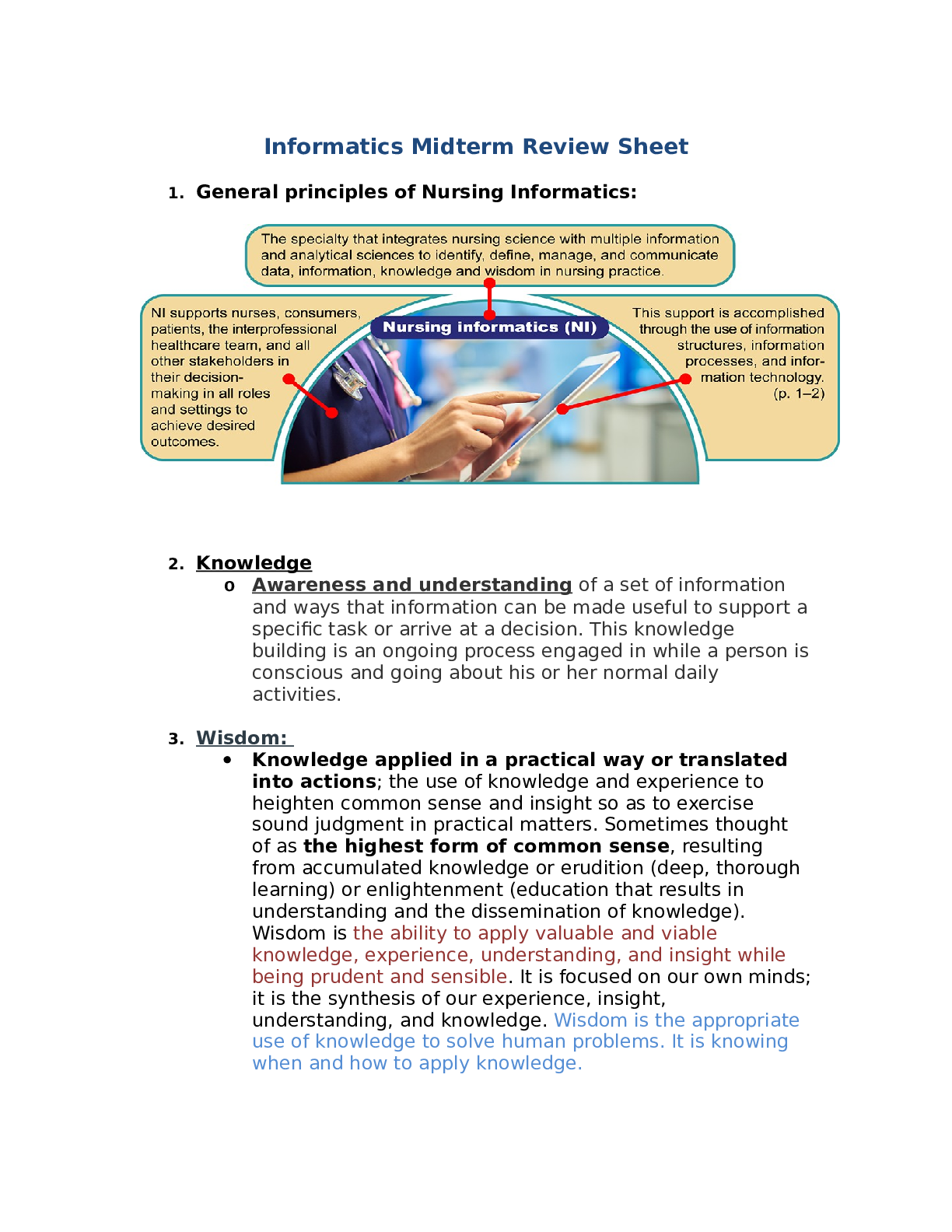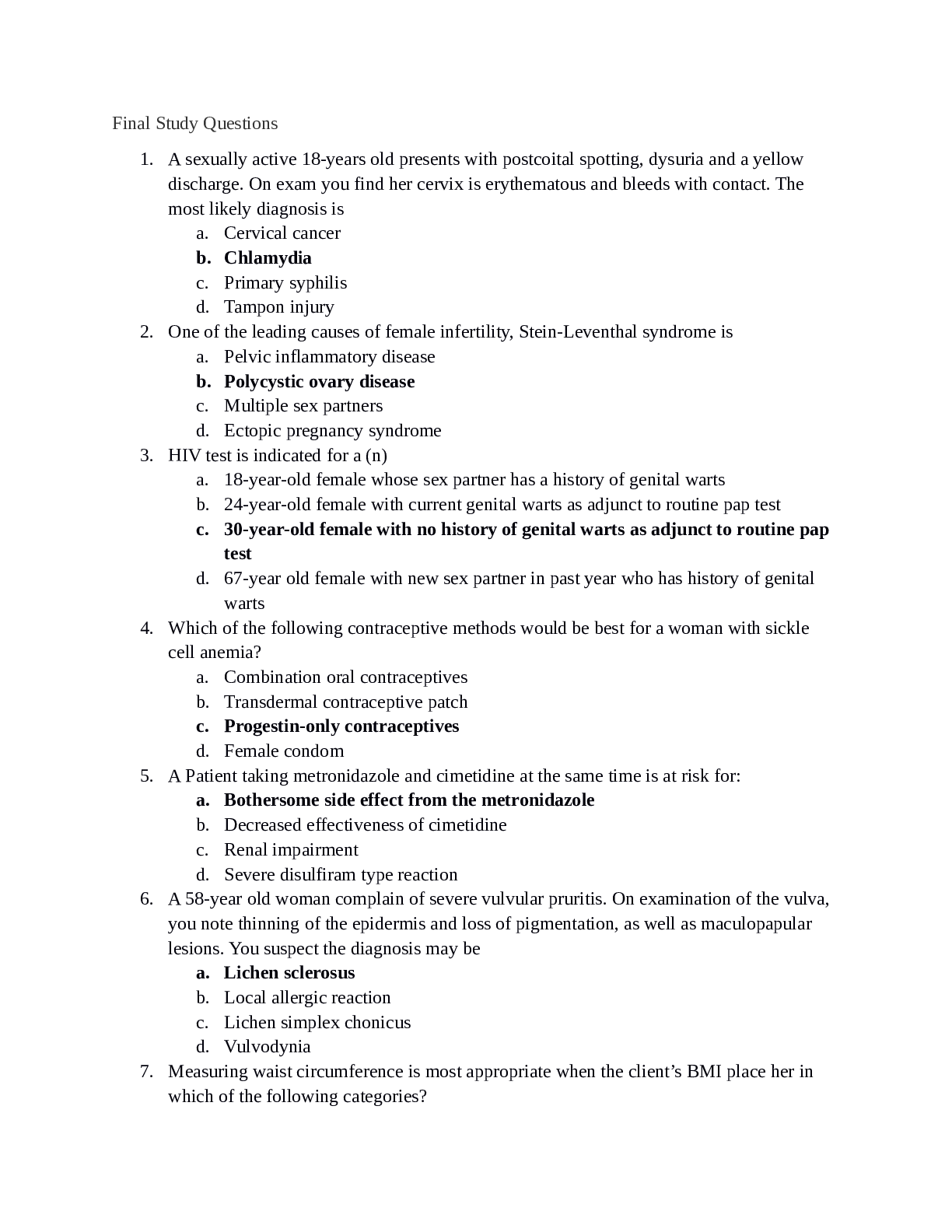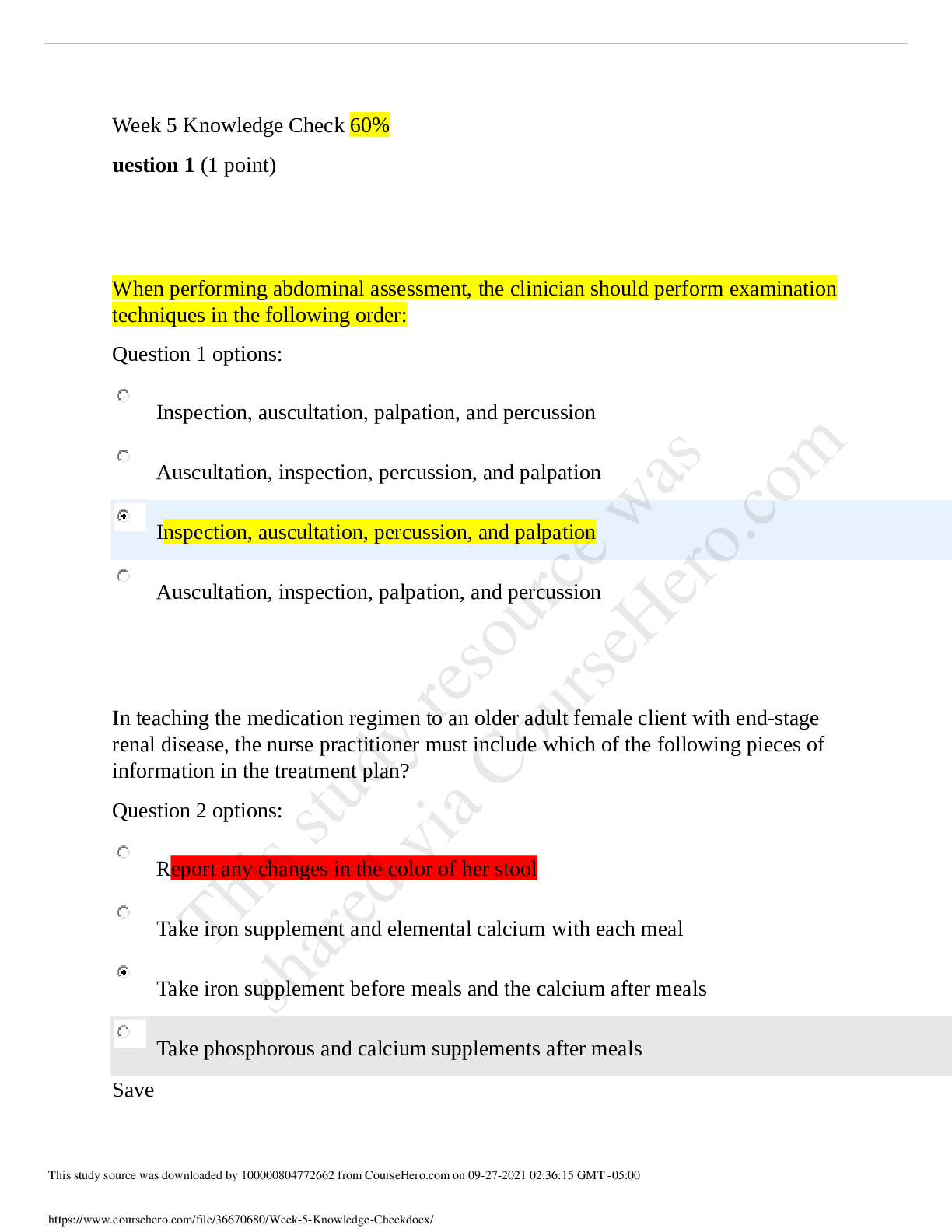*NURSING > EXAM REVIEW > NR 599 midterm review (Electronic health record) | Download To Score An A. (All)
NR 599 midterm review (Electronic health record) | Download To Score An A.
Document Content and Description Below
NR 599 midterm review (Electronic health record) General principles of Nursing Informatics • Verbalize the importance of health information systems with clinical practice. • Have knowledge of... types and clinical and administrative uses of health information systems. • Ensure confidentiality of protected patient health information. • Assure access control in the use of health information systems. • Informatics: Science and art of turning data into info. • Nursing Informatics ANS: The specialty that integrates nursing science with multiple information and analytical sciences to identify, define, manage, and communicate data, information, knowledge, and wisdom in nursing practice. o Nursing Informatics supports nurses, consumers, patients, the inter-professional healthcare team, and all other stakeholders in their decision making in all roles and settings to achieve desired outcomes. o 2 Levels NI practice: generalists and informatics-nurse specialists. Knowledge • Awareness and understanding of a set of information and ways that information can be made useful to support specific task or arrive at a decision • Information that’s synthesized so that relationships are identified and formalized. • Processed information that helps to clarify or explain some portion in our environment or world that we can use a as basis for action or upon which we can act. • Often affected by assumptions and central theories of a scientific discipline and is derived by discovering patterns of relationships between different clusters of information. • Answers questions of “why” and “how” • Data – uninterpreted items, often referred to as data elements. An example might be a person’s weight. Without additional data elements such as height, age, overall well-being it would be impossible to interpret the significance of an individual number. • Information – a group of data elements that have been organized and processed so that one can interpret the significance of the data elements. o For example, height, weight, age, and gender are data elements that can be used to calculate the BMI. The BMI can be used to determine if the individual is underweight, overweight, normal weight or obese. • Knowledge - is built on a formalization of the relationships and interrelationships between data and information. A knowledge base makes it possible to understand that an individual may have a calculated BMI that is over 30 and not be obese. • At this time, several automated decision support systems included a knowledge base and a set of rules for applying the knowledge base in a specific situation. o For example, the knowledge base may include the following information. A fever or elevated temperature often begins with a chill. At the beginning of the chill the patient’s temperature may be normal or even sub-normal but in 30 minutes it is likely the patient will have spiked a temp. A rule might read: if a patient complains of chills, then take the patient’s temperature and repeat in 30 minutes. Wisdom • Appropriate use of data, information, and knowledge in making decisions and implementing nursing actions. • Guides the nurse in recognizing the situation at hand based on patients’ values, nurse’s experience, and healthcare knowledge. • Implies a form of ethics, or knowing why certain things or procedures should or should not be implemented in healthcare practice. • Includes the ability to integrate data, information, and knowledge with professional values when managing specific human problems. • The use of knowledge and experience to heighten common sense and insight so as to exercise sound judgment in practical matters. • Thought to be the highest form of common sense, resulting from accumulated knowledge. • Ability to apply viable and valuable knowledge, experience, understanding, and insight while being prudent and sensible. • Appropriate use of knowledge to solve human problems. Scientific Underpinning • The scientific underpinnings of practice provide the basis of knowledge for advanced nursing practice. • These scientific underpinnings include sciences such as biology, physiology, psychology, ethics, and nursing. • The sciences underpinning nursing informatics: Nursing science, information science, and computer science • The advent of nursing science, specifically middle-range nursing theories, expanded the discipline of nursing. Thorough understanding of nursing theory provides a solid foundation for advanced nursing practice. • The importance of using science-based concepts to evaluate and enhance health care delivery and improve patient outcomes. The Foundation of Knowledge Model • Model that proposes that humans are organic information systems constantly acquiring, processing, and generating information or knowledge in both their professional and personal lives. • Involves integrating four main kinds of knowledge, which are: knowledge acquisition, knowledge dissemination, knowledge generation and knowledge processing. o Knowledge worker: working with info. And generating info and knowledge as a product. o Knowledge acquirer: Providing convenient and efficient means of capturing and storing knowledge. o Knowledge engineers: Designing developing, implementing, and maintaining knowledge. o Knowledge managers: Capturing and processing collective expertise and distributing it. o Knowledge developers and generators: Changing and evolving knowledge based on the tasks at hand and the information available. • With time, we begin to transform our experiences and applied knowledge into it highest form known as...wisdom. • Knowledge is a powerful tool and that nurses focus on information as a key building block of knowledge. Computer science • Studies the theory underpinning information and computation and their implementation in computer systems. • Looks at how the human mind works from an information processing perspective. • Studies the theoretical foundations of information and computation and their implementation and application in computer systems. • Study of storage/memory, conversion and transformation, and transfer or transmission of information in machines. • Algorithms are detailed, unambiguous action sequences in the design, efficiency and application of computer systems, whereas practical implementation problems deal with the software and hardware. • Facilitates the acquisition and manipulation of data and information by nurses, who can then synthesize these into evolving knowledge and wisdom base. Cognitive science • Study of thought, learning, and mental organization, which draws on aspects of psychology, linguistics, philosophy, and computer modeling. • Interdisciplinary field that studies the mind, intelligence, and behavior from an information processing perspective. Information science • Deals with the retrieval and management of information as well as human-computer interactions. • Studies the application and usage of information and knowledge in organizations and the interface or interaction between people. • Concerned with the input, processing, output, and feedback of data and information through technology integration with a focus on comprehending the perspective of the stakeholders involved and then applying IT as needed. • An interdisciplinary, people-oriented field that explores and enhances the interchange of information to transform society, communication science, computer science, cognitive science, library science, and the social sciences. • Encompasses aspect of computer science, cognitive science, social science, communication science, and library science to deal with obtaining, gathering, organizing, manipulating, managing, storing, retrieving, recapturing, disposing of, distributing, and broadcasting information. • Studies everything that deals with information and can be defined as the study of ISs. • Enables the processing of information. • Links people and technology • Impacts information interfaces, influencing how people interact with information and subsequently develop and use knowledge. Standard Terminology (Week 1) • Standardized terminologies (STs) contribute to the development of knowledge because they ensure that all professionals share the same understanding or meaning of a given concept, to clarify communication, facilitate research, and provide structure for decision support tools and EHRs. • As you look at the Foundation of Knowledge model, STs support knowledge acquisition, dissemination, generation, and processing. • Structured controlled languages developed to represent concepts in a given domain in a clear, unambiguous fashion that conveys the exact same meaning for data, information, and knowledge across settings. • Guidelines addressed aspects that include content, concepts, and identification of concepts, hierarchy, relationships and formal definitions. • Are based upon concepts rather than terms and allow for growth over time. • Current Terminology: o Nomenclature refers to a system of rules and procedures for adding names used in an art or science, such as nursing. o Classification systems that capture categories, which are then used to determine costs or outcomes but are insufficient in detail for clinical documentation purposes. o Taxonomy which uses classification according to a predetermined system, with the resulting catalog used to provide a conceptual framework for discussion, analysis, or information retrieval. o Data set which refers to a named collection of data consisting of individual information organized in a prescribed fashion. • International Statistical Classification of Diseases and Related Health Problems (ICD) and Current Procedural Terminology (CPT) provides a description and a classification of known diseases and injuries. o Collection of morbidity and mortality statistics o Automated clinical decision support o Assignment of codes to medical diagnoses and procedures assoc. with hospital utilization in the US. • It improves communication, supports data reuse, contributes to the further development of nursing knowledge and provides a framework for EHRs. Informatics Competencies (Week 2) • Information Literacy: Refers to the use of digital technology to locate, navigate, manage, integrate, evaluate, create, and effectively communicate in a rapidly changing healthcare environment. The most important aspects of information literacy reflect information discovery, retrieval, and delivery as well as the ability to acquire, process, generate, and disseminate knowledge in ways that help those managing the knowledge reevaluate and rethink what an individual understands. o Ability to identify when information is needed as well as the skills to find, evaluate, and effectively use the same o Evaluation of online resources for quality o Able to search literature databases effectively • Computer Literacy o Basic familiarity with computer uses and common applications o Ability to navigate hyperlinks o Able to set up and use a database to collect and retrieve information • Clinical Information Management o Uses clinical decision making (CDS) and system safeguards to protect patients and protected health information (PHI) o Able to request and evaluate reports for the purpose of informed decision making o Participate in the selection, design, and evaluation of clinical information systems and patient-care technologies o Uses available technologies to appropriately and effectively communicate Health literacy (Week 2) • Degree to which individuals have the capacity to obtain, process, and understand basic health information and services needed to make appropriate health decisions. • Is dependent on individual and systemic factors: Communication skills of lay persons and professionals. • Is a major goal of Healthy People 2010 Meaningful Use (Week 3) • The American Recovery and Reinvestment Act of 2009 specifies 3 main components of meaningful use: o Use of certified HER in a meaningful manner, such as e-prescribing o Use of certified HER tech. for electronic exchange of health info. to improve quality of health care o Use of certified HER tech. to submit clinical quality and other measures. • Defined by the use of certified EHR technology in a meaningful manner (for example electronic prescribing); ensuring that the certified EHR technology connects in a manner that provides for the electronic exchange of health information to improve the quality of care. • Developed as an incentive program to assure that EHRs are used according to standards that achieve quality, safety, and efficiency measures • Staged in 3 steps o Stage 1: baseline for electronic data capture and info sharing o Stage 2 & 3 continues to expand on this baseline and be developed through future rule making. Patient-centered Information Systems • EMRs, aggregate information systems, patient unique identifiers. • Aggregated data are used for the generation of routine reports and indicators, and for strategic planning and guidance within the health system. • Focused on collecting data and disseminating info related to direct care. • Most commonly types found in healthcare organizations: o Clinical documentation systems o Pharmacy info systems o Laboratory info systems o Radiology info systems. Clinical Decision Support Systems (CDS) • Provides clinicians, staff, patients or other individuals with knowledge and person-specific information, intelligently filtered or presented at appropriate times, to enhance health and health care. • CDS encompasses a variety of tools to enhance decision-making in the clinical workflow. o These tools include computerized alerts and reminders to care providers and patients; clinical guidelines; condition-specific order sets; focused patient data reports and summaries; documentation templates; diagnostic support, and contextually relevant reference information, among other tools. • Provides HIT functionality that builds upon the foundation of an EHR to provide persons involved in care processes with general and person-specific information, intelligently filtered and organized, at appropriate times, to enhance health and health care • Promotes accurate medical diagnoses and suggest appropriate medical and nursing interventions based on patient data. Electronic Medical Records • Electronic version of a patient’s medical history, that is maintained by the provider over time, and may include all of the key administrative clinical data relevant to that persons care under a particular provider, including demographics, progress notes, problems, medications, vital signs, past medical history, immunizations, laboratory data and radiology report • Computer-based data warehouses or repositories of information regarding the health status of a client, which are replacing the former paper-based medical records. • Systematic documentation of a client’s health status and health care in a secure digital format, meaning that they can be processed, stored, transmitted, and accessed by authorized interdisciplinary professionals for the purpose of supporting efficient, high-quality health care across the client’s healthcare continuum. • Improves patient care by: o Reducing the incidence of medical error by improving the accuracy and clarity of medical records. o Making the health information available, reducing duplication of tests, reducing delays in treatment, and patients well informed to take better decisions. o Reducing medical error by improving the accuracy and clarity of medical records Human-Technology Interface • The study of interaction between human and technology. • With the evolution of technology and computer science, healthcare has been through many developments in respond to tech-world. • Human-Technology Interface in nursing defined as the application of computer technology to all fields of nursing. • It is hardware and software through which the user interacts with any technology (e.g., computers, patient monitors, and digital screens). • Indeed, the use and the development of technology in the clinical areas has become a necessity. Such technology has been already practiced in many nursing departments. o For example, the cardiac monitoring systems, defibrillators, electronic thermometers, intravenous pumps, Patient-controlled analgesia (PCA) pumps and many others hardware. • May present information using text, numbers, images, icons or sound. o Auditory, visual, or even tactile alarms may alert users to important information. • Problems may include: o Nurses devise workarounds, such as removing armband from the patient o Major cause of as many as 87% of all patient monitoring incidents Health Information Technology • HIT has been promoted as a key strategy to achieve better care, affordable care, and healthy populations and communities. • Comprised of “hardware, software, integrated technologies or related licenses, intellectual property, upgrade, or packaged solutions sold as services that are designed for or support the use by healthcare entities or patients for the electronic creation, maintenance, access or exchange of health information. • Involves the exchange of health information in an electronic environment. Widespread use of health IT within the health care industry will improve the quality of health care, prevent medical errors, reduce health care costs, increase administrative efficiencies, decrease paperwork, and expand access to affordable health care. • It is imperative that the privacy and security of electronic health information be ensured as this information is maintained and transmitted electronically. Alarm fatigue (Week 2) • Multiple false alarms by smart technology that cause workers to ignore or respond slowly to them. • the desensitization of a clinician to an alarm stimulus that results from sensory overload causing the response of an alarm to be delayed or missed According to The Joint Commission (TJC) between 2009 and 2012, there were reports of 98 alarm-related sentinel events, in which 80 resulted in death, 13 in permanent loss of function, and five in unexpected prolonged care conditions Digital natives • Person born or brought up during the age of digital technology and therefore familiar with computers and the Internet from an early age. • The term digital native doesn't refer to a particular generation. Instead, it is a catch-all category for children who have grown up using technology like the Internet, computers and mobile devices. Information Literacy Competency Standards for Nursing • The purpose of the Information Literacy Standards for Nursing is to: o provide a framework for faculty and students of nursing at the associate, baccalaureate, master’s, and doctoral levels in the development of information literacy skills for evidence-based nursing practice o encourage the use of a common language for nursing faculty and librarians to discuss student information-seeking skills; o guide librarians and nursing faculty in creating learning activities that will support the growth of information literacy skills over the course of a program of nursing education and for lifelong learning; o provide administration and curriculum committees a shared understanding of student competencies and need; and o provide a framework for continuing education in the area of information literacy for the field of nursing practice and research • Standard One: The information literate nurse determines the nature and extent of the information needed. o Defines and articulates the need for information. o Identifies a variety of types and formats of potential sources for information. o Has working knowledge of the literature in nursing-related fields and how it is produced. o Considers the costs and benefits of acquiring the needed information. o Re-evaluates the nature and extent of the information need. • Standard Two: The information literate nurse accesses needed information effectively and efficiently. o Selects the most appropriate investigative methods or information retrieval systems for accessing the needed information. o Constructs and implements efficient and effectively designed search strategies. o Retrieves information online or in person using a variety of methods. o Refines the search strategy, if necessary o Extracts, records, and manages the in-formation and its sources. • Standard Three: The information literate nurse critically evaluates the procured information and its sources, and, as a result, decides whether or not to modify the initial query and/or seek additional sources and whether to develop a new research process. o Summarizes the main ideas to be extracted from the information gathered. o Selects information by articulating and applying criteria for evaluating both the in-formation and its sources. o Synthesizes main ideas to construct new concepts. o Compares new knowledge with prior knowledge to determine the value added, contradictions, or other unique characteristics of the information. o Validates understanding and interpretation of the information through discourse with other individuals, subject-area experts, and/or practitioners o Determines whether the initial query should be revised. o Evaluates the procured information and the entire process. • Standard Four: The information literate nurse, individually or as a member of a group, uses information effectively to accomplish a specific purpose. o Applies new and prior information to the planning and creation of a particular product. o Revises the development process for the product. o Communicates the product effectively to others. • Standard Five: The information literate nurse understands many of the economic, legal, and social issues surrounding the use of information and accesses and uses information ethically and legally. o Understands many of the ethical, legal, and socio-economic issues surrounding information and information technology. o Follows laws, regulations, institutional policies, and etiquette related to the access and use of information resources. o Acknowledges the use of information sources in communicating the product or performance. HITECH Act • Health Information Technology for Economic and Clinical Health Act was created to motivate the implementation of electronic health records (EHR) and supporting technology in the United States. • President Obama signed HITECH into law on February 17, 2009 as part of the American Recovery and Reinvestment Act of 2009 (ARRA), an economic stimulus bill. • Creates incentives related to health care information technology, including incentives for the use of electronic health record (EHR) systems among providers. • HITECH strengthened HIPPA security. • Providers that comply with meaningful use requirement (EHRs) qualify for additional reimbursement over a period of several years. Penalties will be imposed for providers that do not use approved technology to comply with meaningful use. • Goal is to decrease health disparities. TIGER-based Nursing Informatics Competencies Model (Technology Informatics Guiding Education Reform) • Purpose is to create a vision for the future of nursing that bridges the quality chasm with information tech, enabling nurses to use informatics in practice and education to provide safer, higher-quality patient care. • Pillars of TIGER vision include (p14) o Management and leadership: drives empowers and executes the transformation of health care. o Education: Maximize the possibilities of technology toward knowledge development and dissemination. o Communication and Collaboration: standardized, person-centered, technology-enabled processes to facilitate teamwork across the continuum of care. o Informatics Design: Evidence-based, interoperable intelligence systems o Information Technology: smart people centered technology-enabled processes o Policy: consistent, incentives-based initiatives that support advocacy and coalition-building o Culture: A respectful, open system that leverages technology and informatics across multiple disciplines Review Questions found online: 1. The nurse understands that nursing informatics is recognized as a specialty area of practice by which statement? o Research priorities for nursing informatics include the development of a standard nursing language and the development of databases for clinical information. 2. Which statement by the nurse verifies that the nurse is "information literate"? o "I understand how to search for a website and evaluate its usefulness for health care needs." 3. What is information? o data that can be interpreted. Example: patient’s temperature. Grouping of data process into meaningful structured form. 4. The nurse gathers much data when caring for clients. Which is an example of the higher-level "information" useful in caring for clients? o After receiving Rocephin (ceftriaxone sodium) 1.0 gram IV yesterday, the client reported feeling better today. 5. Which statement best distinguishes the difference between information literacy and computer literacy? o Information literacy forms the basis for ongoing learning whereas computer literacy refers to a familiarity with the use of personal computers 6. Which statement indicates the appropriate level of informatics competencies to the correct nurse? o A nurse informatics specialist extrapolates data to develop best practice model for indwelling catheter care. 7. What is Quality Information? o Information that is timeliness, precision, accuracy, numerically quantifiable, easily available, unbiased, clear and reliable 8. What is data? o A collection of numbers, characters, or facts that are gathered for a need ▪ EX: patients vital signs. Raw unprocessed numbers, symbols or words that have no meaning by themselves. Without context data is meaningless. 9. What is data integrity? o ability to collect, store, and retrieve correct, complete, and current data so data is available to authorized users 10. What is necessary to determine if a website has quality information? o Credited seal, good contact info, not selling things, creditable author, unbiased (things discussed in class) has URAC or HON CODE, updated o Offline: thumb drive, CD, something stored on a medium, not used as much o Online: Safe through network, backs it up, easy access, used more frequently, 11. Computer literate: use of computers, know how to work it, basic computer skills o EX: word processing, spreadsheet, email 12. Information literate: helps ethical issues, can recognize relevance, and know how to apply it Ex: reliable sources 13. Heal literate: ability to understand, obtain, and process basic health information in order to make informed health decisions Ex: definition of medical terms 14. Nursing Informatics: Managing and processing information applying to nursing practice, education, and research. Established and growing area of specialization in nursing. Nurses employ information technologies in their practice 15. Knowledge: Is formed when data is grouped creating meaningful information and relationships which are then added to other structured information. 16. Why do we need to study nurse informatics? o Information is Power and technology facilitates a creative process in nurses, and improves patient education, teaching, and learning 17. What is a common reality that occurs with nursing and technology? o Nurses will be comfortable working with computers and advanced technology while providing care for clients. 18. Definition of Nursing Informatics by ANA: o Specialty that integrates nursing science, computer science to manage and communicate data , info and knowledge in nursing practice 19. What are the functions of computers in Nursing Practice? o Record information, provide access to other departments, manage schedules 20. What is Telehealth? o Uses technology to access, diagnose, and treat at a distance ▪ Examples of Telehealth devices: BP, pulse oximeters, scales, video monitors 21. What is biometric technology? o Using human characteristics to authenticate or grant access to data or information 22. How do human resources use computers? o Employee database, administration services 23. How do medical records management use computers? 24. What is the definition of information technology? o hardware and software facilitates storage retrieval, communication, and management of information 25. What is the definition of computer literacy? o knowledge and understanding of computers with effective use 26. How do you identify problems? o Locate current literature and related concepts 27. What is the 3 things needed when looking for information online? o Define Purpose: Why are you doing the search? Why do you need this information? o Define Focus: Basic information for you, lay oriented for your patients, professionally orientated for you colleagues o Define Approach: Broad and general with information that can be quickly accessed 28. Edu: education org: nonprofit organization com: commercial enterprise net: internet provider gov: governmental body mil: military 29. A disadvantage to the utilization of the electronic medical record (EMR) includes which of the following? o The intensive training in the beginning needed to prepare staff members to use the EMR 30. Which action indicates the nurse is functioning as a knowledge worker? o The nurse auscultates diminished breath sounds in a postoperative client the morning after abdominal surgery and encourages the client to turn, cough, and deep breathe every hour instead of every two hours. 31. A nurse manager wishes to hire a new nurse who has just graduated from nursing school. At the beginning level of informatics competencies, the nurse should be able to do which of the following? o Input vital signs and intake and output data in the electronic medical record. 32. In which way does medical informatics overlap with nursing informatics? o Medical and nursing informatics focus on the areas of information retrieval. 33. Health care consumers have all the information and tools to make health care choices because they can easily compare quality and cost of care. Which of the following is correct? o The statement is false because the tool has not been developed. 34. The role of the informatics nurse does not include assessing the usability of devices for health care consumers. This statement is false because of which of the following reasons? o The development of policy regarding usability is an important part of the informatics nurse's role. 35. Over the next few years, nursing informatics and other health informatics disciplines will crisscross, resulting in more interdisciplinary projects. This statement is true because of which of the following reasons? o Nurse informatics specialists will work collaboratively with other disciplines to develop user- friendly systems. 36. The best estimate of the number of informatics nurses needed over the next few years is which of the following? o 6000 to 12,000 37. There are no available nursing informatics programs including doctoral degrees; therefore, nurses prepare for advanced practice through medical informatics curriculum. This answer is false because of which of the following reasons? o There are a number of accredited advanced nursing education programs in informatics in the United States. 38. The American Nurses Credentialing Center (ANCC) incorporated the foundation provided by the American Nurses Association (ANA) in its definition of nursing informatics and scope and standards of practice. Applicants for the Informatics Nurse credentialing examination are required to meet which of the following minimum criteria? o Equivalent of two years of full-time professional practice, Baccalaureate or higher degree in nursing (or relevant field baccalaureate), Current, active license as a professional nurse 39. Nursing informatics employs information and computer technology to support all aspects of nursing practice, including research. Which is an example of supporting research? o Development of a standardized nursing language 40. Which role is only appropriate for the informatics nurse specialist (INS)? o The design of nursing research protocols and databases 41. Which of the following examples demonstrate how nursing informatics helps to support nursing practice? o Standard Text: Select all that apply. ▪ Quick access to computer-archived patient data from previous encounters ▪ Computer-generated client documentation including discharge instructions ▪ Computer-generated nursing care plans and critical pathways ▪ Prompts that appear during documentation to ensure comprehensive charting 42. Information is defined as which of the following? o Interpreted data 43. Nurses need to become skilled at using patient-centered IT tools to access information that can expand their knowledge in a just-in-time, evidence-based approach. Which one of these answers best indicates the nurse is functioning as a knowledge worker? o The nurse shifts from primarily using critical thinking to also using critical synthesis. 44. The TIGER initiative is an acronym for which of the following? o Technology Informatics Guiding Education Reform 45. The Quality and Safety Education for Nursing (QSEN) project sets an agenda to improve the quality and safety of the health care delivery system. To achieve the goals set by QSEN, the Institute of Medicine (IOM) suggested the following competencies for nurses except for which of the following? o Professional code of conduct 46. Technology has been useful in reducing errors by assisting the health care team to identify the patient before rendering care. The most common way for nurses to identify patients using technology is through which of the following? o Use of barcodes 47. Access to patient care data and utilization of nursing research are essential components of evidence-based practice designed to increase patient safety and provide quality care. Which of the following can technology cannot be employed to remove barriers to information and evidence-based practice? o Online report cards 48. The reason that nursing lags behind in the education of nursing informatics specialists is because of which of the following? o The lack of qualified faculty in graduate program 49. Which of the following groups have been selected to help drive the changes necessary to transform the health care delivery system, improve quality of services delivery, and improve safety? o Informatics nurse specialists 50. The Informatics Nurse Specialist is an integral member of the health care team with the expertise to: Create standardized nursing languages. 51. Which of the following answers is the best definition of data? o Data are a collection of numbers, characters, or facts that are gathered according to some perceived need for analysis and possibly action at a later point in time. 52. What is the key impediment of telehealth? o Licensure 53. What are the benefits of nursing terminologies? o Increased visibility, better communication, involved patient care, enhanced data collection, adherence to standards 54. What are NANDA, NIC, NOC, CCC, PNDS, NMDS? o Examples of nursing terminologies 55. Research that generates knowledge for nursing practice is called? o Evidence based practice 56. What are the three sciences that nursing informatics utilized in the definition? o Nursing science, computer science, and information science 57. Nursing informatics focuses in what four concepts? o Data, information, knowledge, and wisdom 58. What are raw facts that lack meaning? o Data 59. What are the modules of CDSS? o Reminders, alerts, drug/drug, drug/allergy checking, guidelines and protocols, image recognition, and interpretation 60. What filed attempts to capture the complex process of the human thought and intelligence? o Artificial intelligence 61. What is the longitudinal electronic record of patient health information produced by encounters in one or more care settings? o EHR - electronic medical record 62. What are at least two economic benefits of telehealth? o Decrease ER visits, decrease length of stay, decrease admission, decrease travel costs, increase in productivity of clinicians 63. What is the definition of nursing terminologies? o A systematic standardized way of describing nursing practice and includes data sets, taxonomies, nomenclatures and classification 64. The number one focus of EHR as stated by the IOM? o Patient safety 65. What are the components of the metaparadigm of nursing? o Nurse, patient, health, environment 66. Who are the consumers of telehealth technology? o Chronically ill, isolated, concerned families and assisted living patients 67. A DSS or CDSS should support, not replace what of a clinician or manager? o Judgement and critical thinking 68. What are 3 peripheral devices used in telehealth? o Scale, BP monitor, pulse oximeter, thermometer, glucometer, EKG or heart monitor, PTT/INR meter, camera 69. What is a system designed to support health care providers in making decision about the delivery and management of patient care? o Clinical decision support system 70. What module is used to enter meds and other orders into the computer? o Order entry management 71. What allows the clinician to be in contact with a patient without a face to face encounter? o Telehealth 72. People who share a specialized knowledge? o Profession 73. What is the ability to apply appropriate use of knowledge to manage and solve human problems? o Wisdom 74. What is a RN with an advanced education possess additional knowledge skills to computer and information technology? o Nurse informatics specialist 75. What is the goal of nursing informatics? o Improve health of populations, communities, families and individuals by optimizing information management and communication 76. Data that is interpreted, organized or structured? o Information 77. Information that is synthesized so that relationships are identified and formalized? o Knowledge 78. The appropriate use of knowledge to manage and solve human problems? o Wisdom 79. Process of actively and skillfully using knowledge to apply analyze, synthesize and/or evaluate data and information? o Critical Thinking 80. Informatics- The interdisciplinary study of the design, application, use, and impact of information technology. 81. Nursing Informatics- A combination of computer, information, and nursing science designed to assist in the management and processing of nursing data, information, and knowledge. 82. Healthcare Informatics- AKA Clinical Informatics Directed at the level of individuals An umbrella term including medical, dental, and nursing 83. Benefits of Nursing Informatics: -Enhances practice and allows nursing science to develop -Improves documentation (saves time) -Uses data for quality control and research -Builds evidence-based nursing knowledge 84. Informatics Pyramid (Bottom to Top): Data --> Information --> Knowledge --> Wisdom 85. Structured Data: Follows standards; easily shared; less flexible, reliable reporting 86. Unstructured Data: Easy to use; flexible; requires analytics; not as reliable; not as easily shared 87. Evidence-Based Practice: Provides basis for clinical guidelines and clinical decision support 88. Clinical Decision-Making: Choices are based on the idea that research-based care improves outcomes 89. Knowledge Transformation: The conversion of research findings through a series of stages to impact health outcomes. 90. Star Model of Knowledge Transformation: o 1. Discovery Research o 2. Evidence Summary o 3. Translation to Guidelines o 4. Practice Integration o 5. Process, Outcome, Evaluation 91. Translation to Guidelines: Experts are called upon to consider evidence summary, fill in gaps, and merge research knowledge with expertise to form Clinical Practice Guidelines (CPGs) 92. Meaningful Use: Established to -Improve quality, safety, and efficiency -Engage patients and families in care -Improve coordination of care -Improve public and population health -Ensure privacy and security 93. HITECH Act: Health Information Technology for Economic and Clinical Health - 2009 Promotes adoption and meaningful use of health IT 94. EHR: Electronic Health Record; a longitudinal electronic record of patient health information generated by one or more encounters in any care delivery setting 95. EMR: Electronic Medical Record; a legal record created in hospitals and ambulatory environments that is the source of data for the EHR. Centered around a single episode of treatment. 96. PHR: Personal Health Record; contains data input by a patient on his or her own behalf, owned by the patient, and extends across multiple providers and encounters [Show More]
Last updated: 1 year ago
Preview 1 out of 20 pages
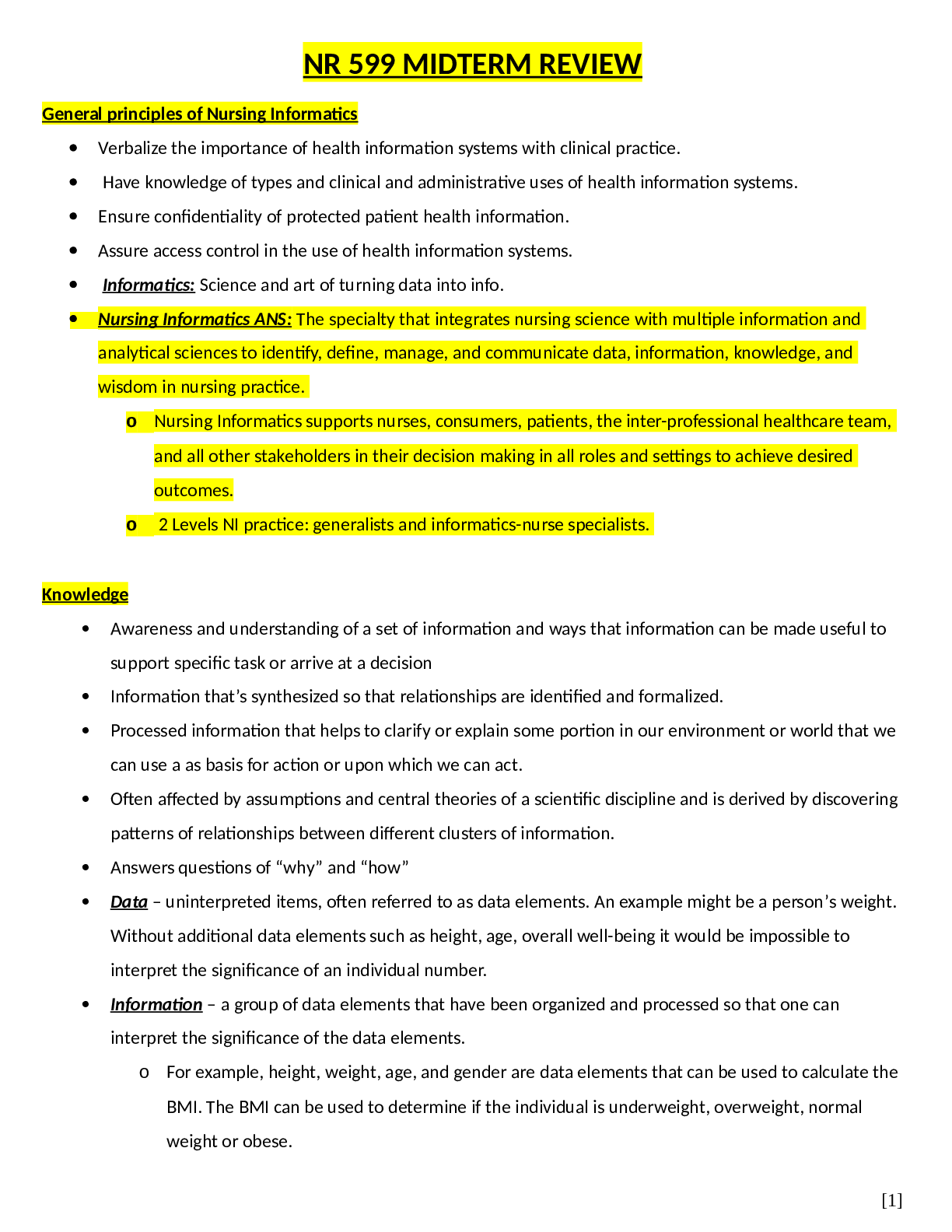
Reviews( 0 )
Document information
Connected school, study & course
About the document
Uploaded On
Oct 21, 2021
Number of pages
20
Written in
Additional information
This document has been written for:
Uploaded
Oct 21, 2021
Downloads
0
Views
43




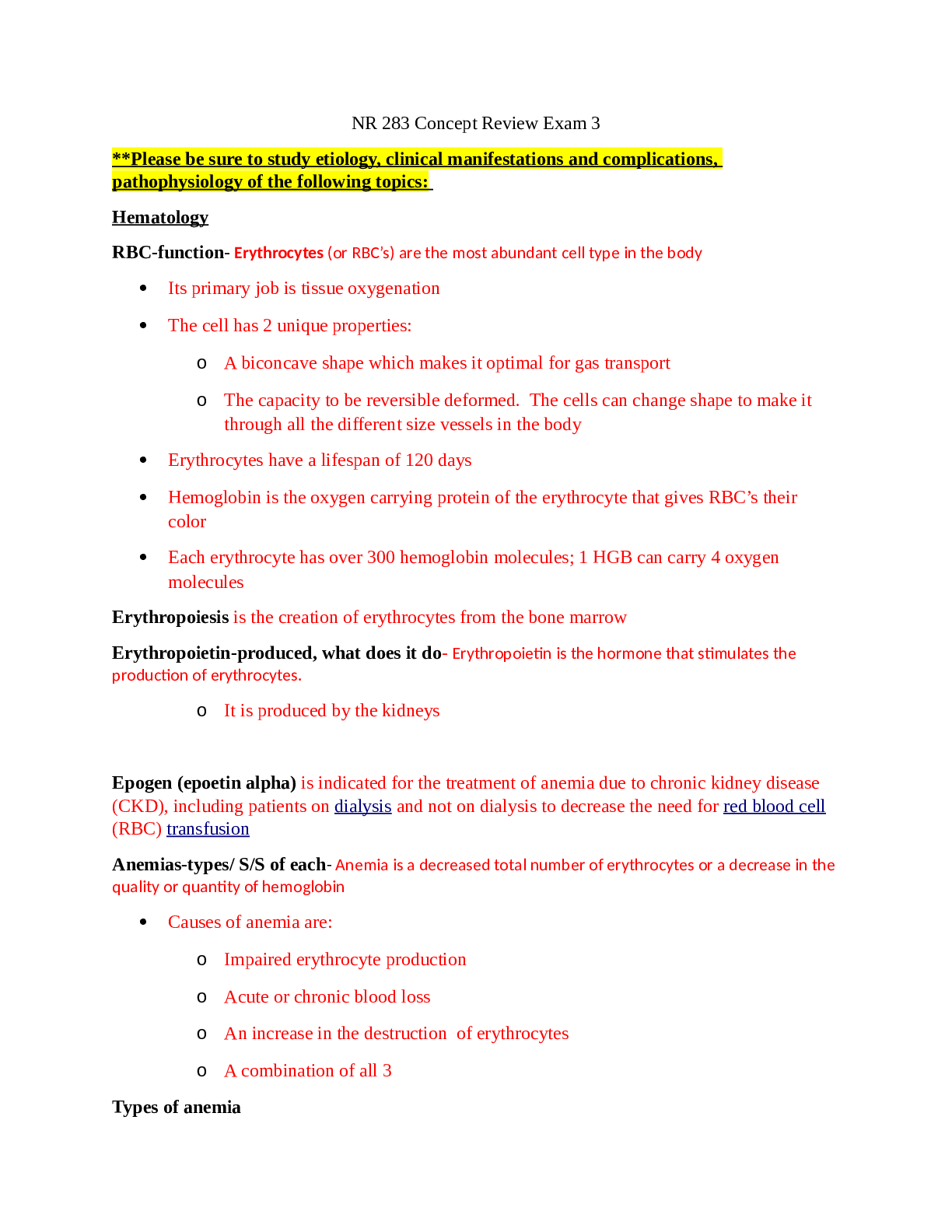
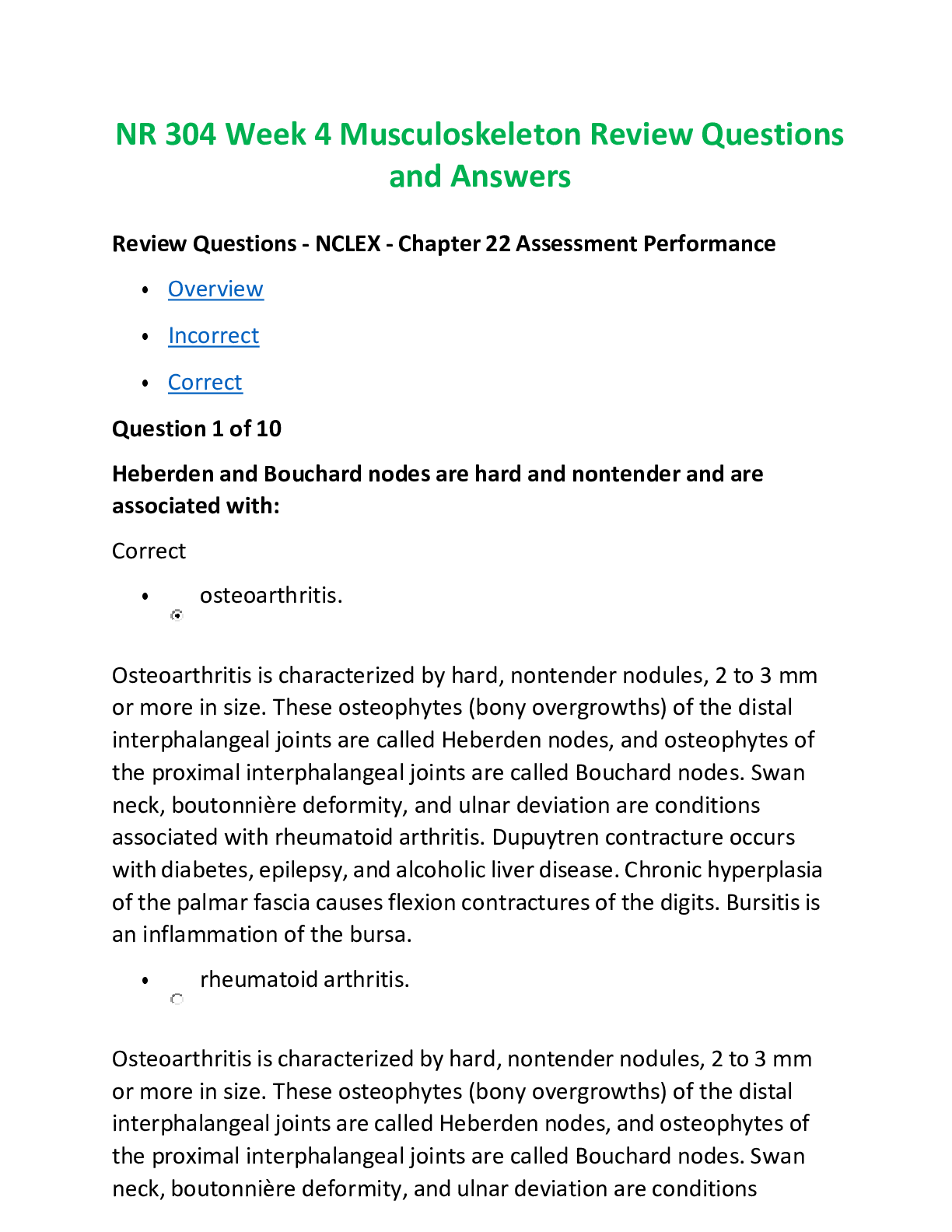

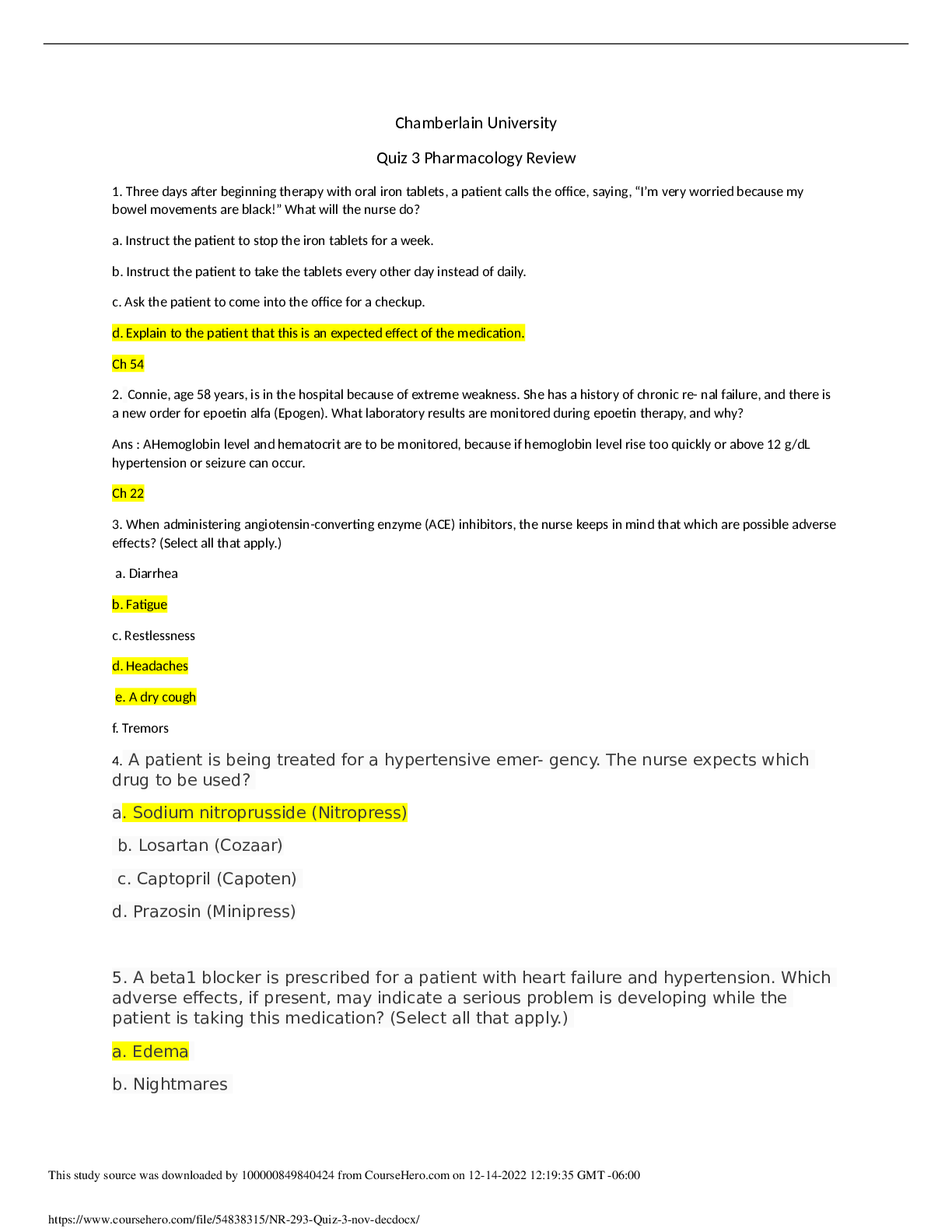

.png)
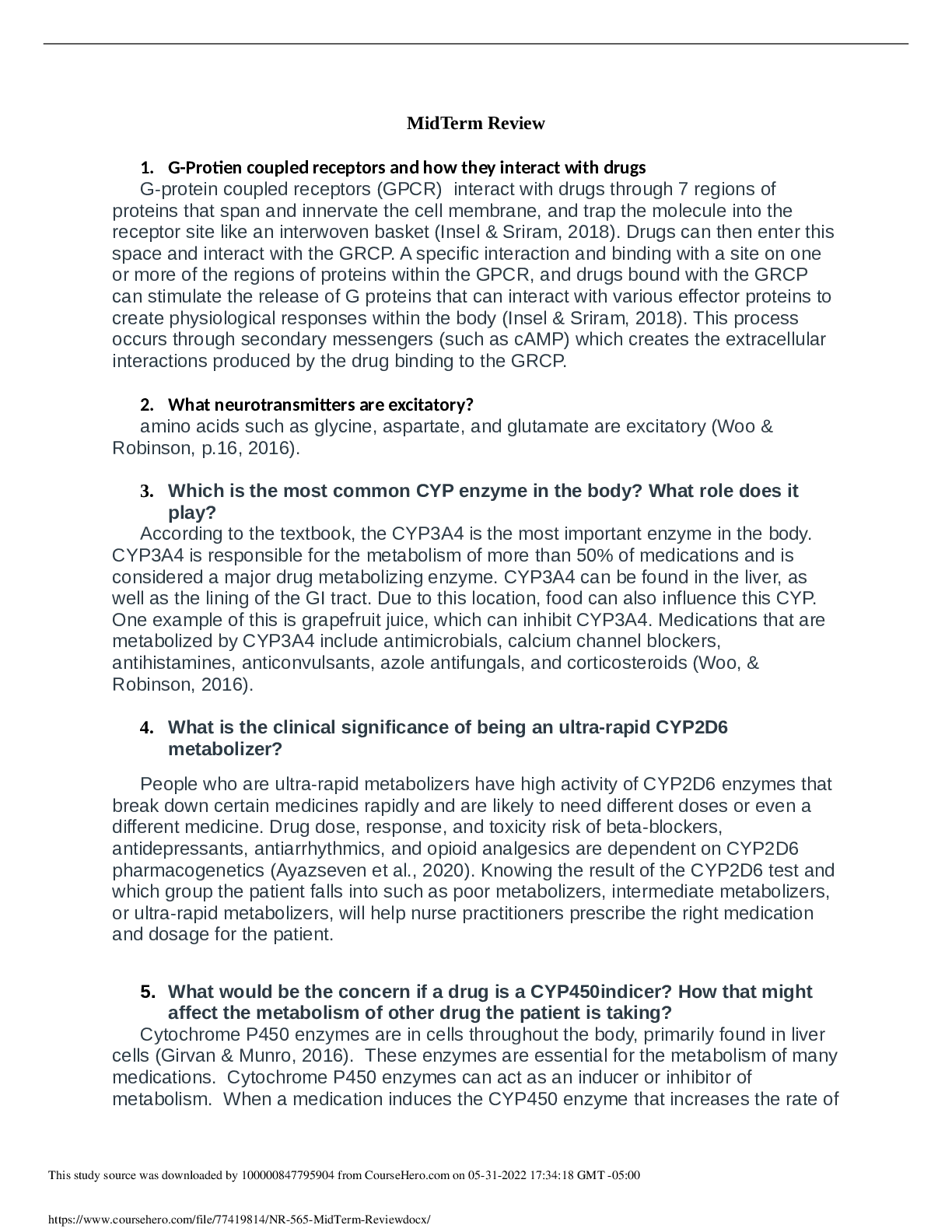
.png)

